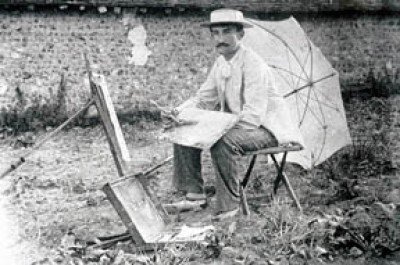
Guy Orlando Rose stands as one of the most significant figures in American Impressionism, particularly celebrated for his luminous depictions of the California landscape. Born in San Gabriel, California, on March 3, 1867, Rose emerged from a prominent family; his father, Leonard John Rose, was a successful rancher, vintner, and later a California State Senator. This background provided a degree of stability, yet Rose's early life was marked by a formative challenge that inadvertently steered him towards his artistic destiny.
A hunting accident involving his brother during his childhood resulted in Guy being accidentally shot in the face. The long recovery period confined him, and it was during this time of convalescence that he began to seriously explore drawing and painting, initially in watercolor and later in oils. This early immersion in art laid the groundwork for what would become a lifelong passion and profession. His innate talent was evident, prompting his family to support his artistic inclinations.
Early Training and Parisian Aspirations
Following his graduation from Los Angeles High School in 1884, Rose's formal art education began at the California School of Design in San Francisco. Under the tutelage of artists like Virgil Williams and Emil Carlsen (though Carlsen's tenure was brief), Rose honed his foundational skills. However, like many ambitious American artists of his generation, the allure of Paris, the undisputed center of the art world at the time, proved irresistible.
In 1888, at the age of 21, Rose embarked for Paris to further his studies at the prestigious Académie Julian. This institution was a magnet for international students, offering a more liberal alternative to the rigid École des Beaux-Arts. There, he studied under influential academic painters including Jules Joseph Lefebvre, Jean-Joseph Benjamin-Constant, and Lucien Doucet. These instructors imparted a strong grounding in draftsmanship and traditional techniques, which would underpin Rose's later Impressionist explorations.
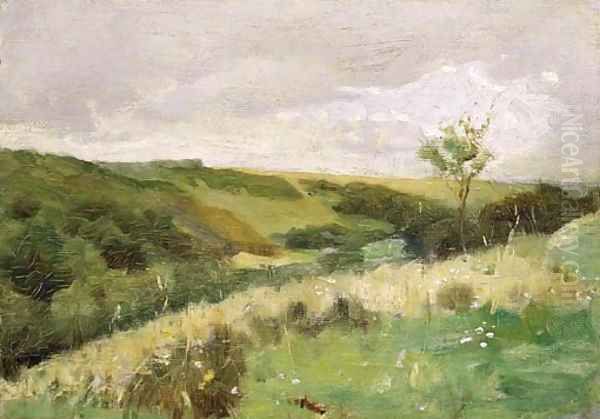
Rose quickly distinguished himself. In 1889, he achieved a significant milestone by becoming the first California-born artist to receive an honorable mention at the Paris Salon, the official, highly competitive art exhibition of the Académie des Beaux-Arts. This early recognition signaled his potential on an international stage and validated his decision to pursue advanced training in Europe. His time in Paris exposed him not only to academic traditions but also to the revolutionary currents of Impressionism that had reshaped French art.
Immersion in Giverny and the Influence of Monet
While Rose absorbed the lessons of his academic teachers, the vibrant colors and light-filled canvases of the French Impressionists increasingly captured his imagination. The most profound influence came from Claude Monet, the standard-bearer of the movement. Although Rose likely encountered Impressionist works earlier, his connection deepened significantly when he moved to Giverny, the small village northwest of Paris where Monet had lived and worked since 1883.
In 1899, Guy Rose and his wife, Ethel Rose, whom he had married in 1895, purchased a cottage in Giverny. This move placed them directly within the orbit of Monet and the burgeoning colony of American artists who had gathered there, drawn by the master's presence and the picturesque Norman countryside. Rose lived in Giverny for much of the period between 1900 and 1912. During these years, he developed a close friendship with Monet, who acted as both a mentor and a peer.
The impact of Monet and the Giverny environment on Rose's art was transformative. He fully embraced Impressionist principles, focusing on capturing the fleeting effects of light and atmosphere en plein air (outdoors). His palette brightened considerably, and his brushwork became looser and more broken, characteristic of the Impressionist style. He painted the local gardens, hillsides, and the Seine River, often revisiting motifs under different light conditions, echoing Monet's own practice. A notable work from this period is Giverny Hillside (c. 1890-1891), showcasing his early engagement with the landscape and light of the region.
Rose became a central figure among the American expatriates in Giverny. This group included talented painters like Frederick Carl Frieseke, Richard E. Miller, Lawton S. Parker, and Alson Skinner Clark (who would also become a prominent California Impressionist). These artists often painted together, shared ideas, and exhibited collectively. In 1910, Rose, Miller, and Parker were part of a significant exhibition titled "The Giverny Group" held at the Madison Gallery in New York City, showcasing their distinct interpretations of French Impressionism applied to the Giverny landscape. Earlier American artists associated with Giverny, like Theodore Robinson and Willard Metcalf, had paved the way for this second wave.
Navigating Challenges: Lead Poisoning and Travels
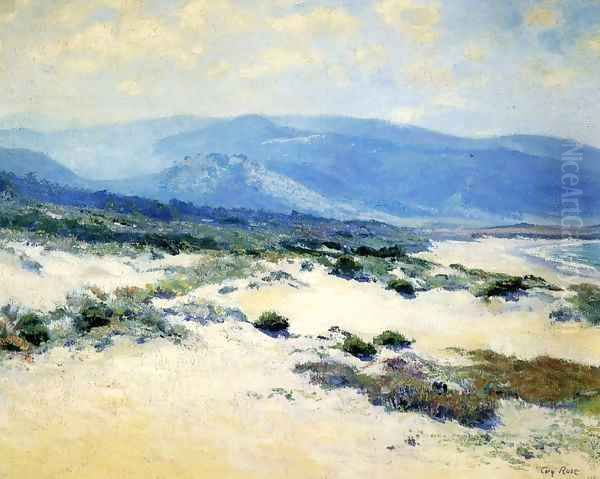
Rose's artistic journey was not without significant obstacles. A major setback occurred in 1894, even before his extended Giverny period. He suffered a severe bout of lead poisoning ("painter's colic"), a common ailment among artists at the time due to the lead content in white oil paints. This illness was debilitating, forcing Rose to abandon oil painting for several years. During this hiatus, he returned to the United States and worked primarily as an illustrator for magazines like Harper's, Scribner's, and The Century.
His resilience eventually allowed him to resume oil painting around 1899, coinciding with his move to Giverny. However, the effects of lead poisoning may have lingered, potentially influencing his later health issues. Despite this challenge, his Giverny years were highly productive. His travels also broadened his subject matter. Around 1900, he spent a winter in Briska, Algeria, producing a small number of known paintings capturing the North African light and scenes, demonstrating his versatility beyond the French countryside.
Before permanently returning to California, Rose and his wife spent the summers of 1913 and 1914 in Narragansett, Rhode Island. There, he taught outdoor sketching classes, sharing his plein air techniques honed in France with American students. This brief teaching stint foreshadowed his later educational role in California.
Return to California: Master of the Golden State's Light
In 1914, with the outbreak of World War I imminent in Europe and perhaps seeking a climate more conducive to his health, Guy Rose and Ethel returned permanently to the United States, settling in Pasadena, California. This marked the beginning of the final, highly celebrated phase of his career, during which he applied his mature Impressionist style almost exclusively to the landscapes of his native state.
Southern California, with its distinct geography and intense, clear light, provided Rose with a wealth of new inspiration. He became one of the foremost painters dedicated to capturing the unique atmospheric conditions and scenic beauty of the region – what critics often termed the "California Light." His subjects ranged from the rugged coastline of Carmel and Monterey Bay, the rolling hills dotted with oaks and eucalyptus near Pasadena and the Arroyo Seco, to the serene beaches of Laguna and La Jolla, and occasionally the majestic Sierra Nevada mountains.
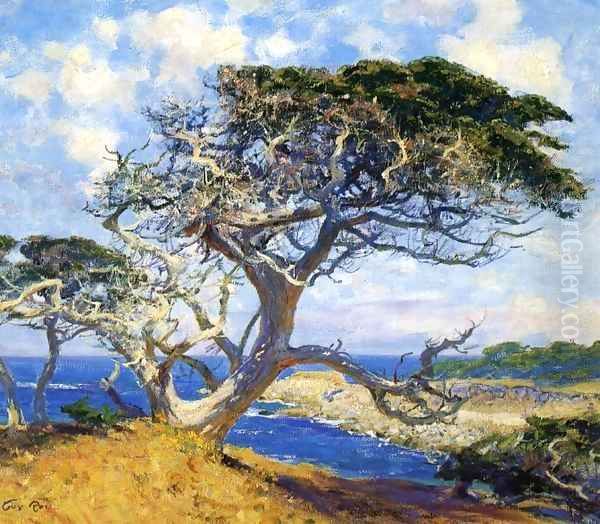
Rose's California works are characterized by their sophisticated color harmonies, confident brushwork, and masterful rendering of light and shadow. He excelled at depicting the hazy mornings, the bright midday sun reflecting off the Pacific, and the warm glow of late afternoon light on the coastal cliffs and mountains. Works like Carmel Shore, Monterey Cypress, and Laguna Eucalyptus exemplify his ability to convey both the grandeur and the subtle nuances of the California landscape. His painting Out to Sea, Point Lobos (1918) is considered one of his masterpieces, capturing the dramatic meeting of land and sea with vibrant color and dynamic composition.
He quickly became a leading figure in the burgeoning Southern California art scene, associating with other prominent California Impressionists such as William Wendt, Granville Redmond (known for his poppy fields and nocturnes), the adventurous landscape painter Edgar Payne, and the floral and landscape artist Franz Bischoff. While sharing an interest in Impressionism and the California landscape, Rose's style remained distinct, often noted for its refinement and strong French influence, particularly the structural sense inherited from his academic training blended with Monet's sensitivity to light.
Educator and Influential Figure
Beyond his own artistic production, Guy Rose played a significant role in art education in Southern California. Shortly after his return, he began teaching at the Stickney Memorial School of Art in Pasadena, a respected institution that attracted many aspiring artists. His reputation and expertise quickly led to his appointment as the school's Director, a position he held for several years.
His teaching emphasized the principles of French Impressionism, particularly the importance of outdoor painting and capturing the effects of natural light. He encouraged students to develop strong technical skills while fostering an individual approach to color and composition. Although specific lists of his students are not widely documented, his influence extended through his instruction and his prominent example as a successful artist working in an Impressionist mode. He helped solidify Impressionism as the dominant style in Southern California during the 1910s and early 1920s.
Rose was also active in local art organizations, exhibiting frequently and contributing to the region's growing cultural identity. He was a member of the California Art Club and the Ten Painters Club of California, groups that played crucial roles in promoting landscape painting and organizing exhibitions. His presence lent prestige to the local art scene, bridging the gap between European sophistication and the developing artistic traditions of the American West.
Artistic Style and Technique Revisited
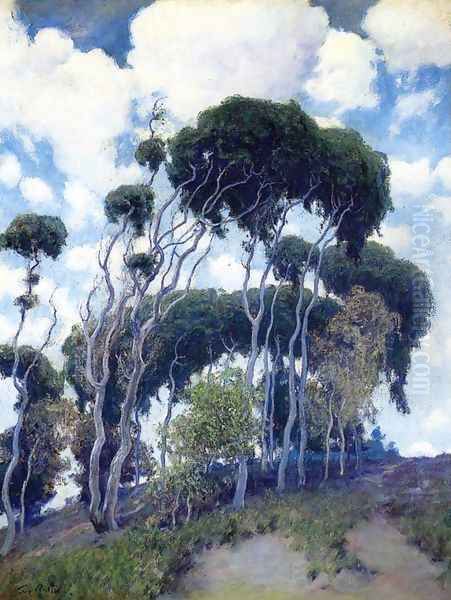
Guy Rose's mature style represents a compelling synthesis of French Impressionist aesthetics and the specific qualities of the California environment. His technique involved using broken brushstrokes, applying dabs or commas of relatively pure color side-by-side, allowing the viewer's eye to blend them optically. This method created canvases that shimmer with light and atmospheric vibrancy.
His palette was typically high-keyed but carefully controlled, employing subtle variations in hue and value to model forms and suggest depth. He was particularly adept at capturing the cool blues and violets of shadows contrasted with the warm yellows, oranges, and pinks of sunlit areas, a hallmark of Impressionist color theory. Unlike some Impressionists who dissolved form completely into light, Rose often retained a sense of underlying structure and solidity in his landscapes, likely a legacy of his academic training under Lefebvre and Benjamin-Constant.
While primarily known for landscapes, Rose occasionally included figures in his compositions, often depicted leisurely within a sun-dappled garden or coastal setting. These figures are typically integrated into the overall play of light and color, serving as focal points or elements that enhance the sense of atmosphere rather than being detailed portraits. His Giverny works often feature figures, while his later California paintings focus more purely on the power and beauty of the natural landscape itself.
Later Years, Legacy, and Market Recognition
Guy Rose continued to paint prolifically throughout the late 1910s, producing many of his most acclaimed California landscapes during this period. His work was widely exhibited and well-received by critics and collectors on both the West and East Coasts. He achieved a level of success and recognition few California artists of his time could match.
Tragically, his productive career was cut short by declining health. In 1921, Rose suffered a severe, debilitating stroke that left him paralyzed. He was forced to give up painting entirely. He spent the last four years of his life incapacitated, a poignant end for an artist so dedicated to capturing the vitality of the natural world. Guy Rose passed away in Pasadena on November 17, 1925, at the age of 58.
Despite the brevity of his mature California period (roughly 1914-1921), Guy Rose left an indelible mark on American art history. He is consistently ranked among the most important California Impressionists and a significant figure in the broader American Impressionist movement. His works are admired for their technical brilliance, aesthetic beauty, and evocative portrayal of specific locales in both France and California.
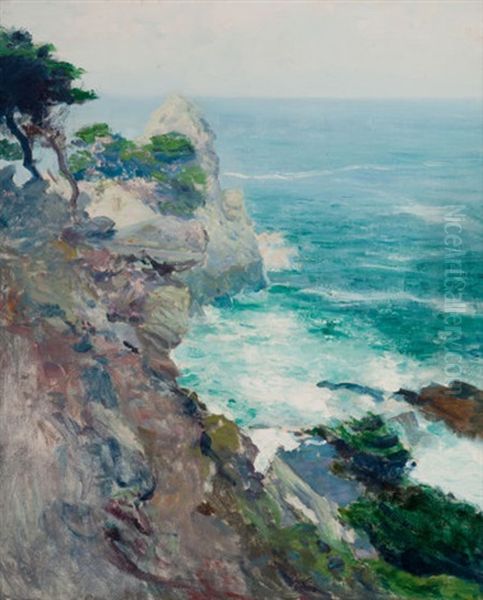
His legacy is preserved in the numerous paintings held by major museum collections across the United States, including the Los Angeles County Museum of Art (LACMA), the Crocker Art Museum in Sacramento (which holds Monterey Cypress), the Oakland Museum of California, the Irvine Museum Collection at the University of California, Irvine (a key repository of California Impressionism), and the Museum of Fine Arts, Boston, among others.
In recent decades, Guy Rose's work has commanded significant attention in the art market. His paintings, particularly major California coastal scenes, are highly sought after by collectors and have achieved substantial prices at auction. For example, Out to Sea sold for .97 million at Sotheby's in 2005. Lowtide Honfleur fetched 8,000 in 2009. Works like Carmel Shore and Normandy Farm carried high estimates (though final sale prices weren't specified in the source data), reflecting his esteemed position in the market. This strong market presence underscores the enduring appreciation for his artistic contributions.
Conclusion: An Enduring Vision
Guy Rose's life and art represent a fascinating journey from a privileged California upbringing, through rigorous European training and immersion in the heart of French Impressionism, to a triumphant return focused on capturing the unique essence of his native state. He successfully navigated the transition from academic tradition to modern Impressionism, forging a style that was both indebted to French masters like Monet and distinctly his own, perfectly suited to the landscapes he loved.
As a painter, he possessed a rare combination of technical skill, sensitivity to light and color, and a profound connection to place. As an educator and influential figure, he helped shape the course of art in California during a critical period of its development. Guy Rose remains a pivotal artist, celebrated for his luminous, evocative canvases that continue to resonate with viewers, offering timeless visions of the beauty of Giverny and the golden light of California. His work stands as a testament to the power of Impressionism to capture the fleeting moments of beauty in the natural world.